AI
our blog
From Novelty To ROI: How Agentic Systems Are Starting To Deliver

Agentic AI is all over LinkedIn right now - systems that can reason, take action and adapt. But a lot of the chatter still feels like theory or hype. What we’re more interested in is what’s actually happening on the ground: agentic workflows quietly making their way into real businesses, improving how day to day work gets done.
For mid-cap and enterprise teams, the focus has shifted. It’s less about whether the tech can do something and more about whether it’s worth it. What’s the ROI? That’s where agentic systems are starting to prove useful. Not across every team or process, but in enough places to matter.
We’ve seen it in operations, where AI-powered machine vision is helping teams spot issues faster and cut costs. It’s not just showing data but acting on it, flagging problems in real time and learning as it goes.
We’ve also seen it in finance, where forecasting tools are doing more than running models. They’re processing market data, identifying patterns and suggesting what’s likely to happen next. So faster, better informed decisions from the same team.
We’ve even seen it first hand at Studio Graphene in internal tooling. We’ve used AI to strengthen our own platforms like Pulse and Telsen, pulling together fragmented data to give teams clearer visibility on performance, productivity and risk.
And we’ve seen it in areas like procurement and DEI. We built a Catalogue Fixer that uses AI to automatically clean and enrich messy supplier data, cutting hours of admin and reducing errors. For a DEI benchmarking platform, we used AI to help businesses assess their current standing, spot gaps and access tailored learning resources, giving teams something they could actually act on.
Not every use case we’ve worked on involves a fully autonomous, self improving system because what matters at this stage is the intent behind them. Many of these tools already reflect agentic thinking. They don’t just surface information, they take action based on it. They reduce manual effort, speed up everyday decisions and improve with use. That shift from passive dashboards to active systems is where we’re seeing real progress.
Clarity and focus matter. Find a specific point of friction, repetitive, time consuming tasks that slow things down and apply the right tech to fix it. Surface errors in real time. Make sense of messy data. Help teams act faster on what they already know. A targeted agentic system can improve the workflow without needing to rebuild it.
The technology is ready. And as we always say, the value in AI comes from how it’s applied.









